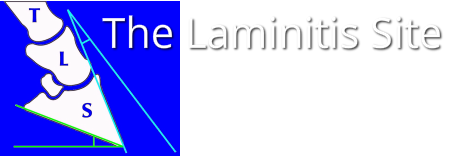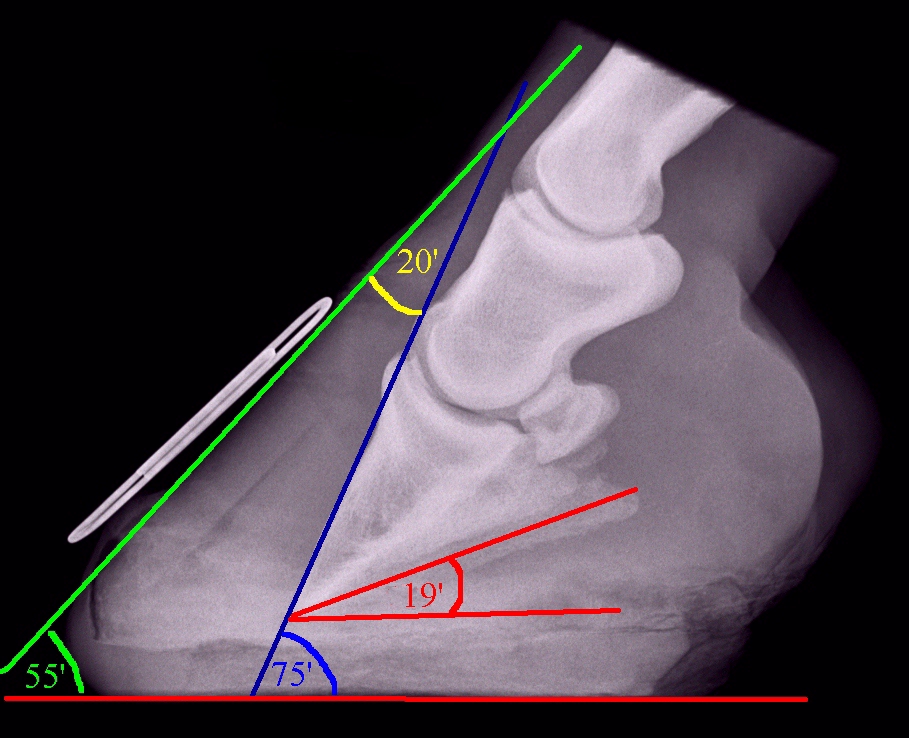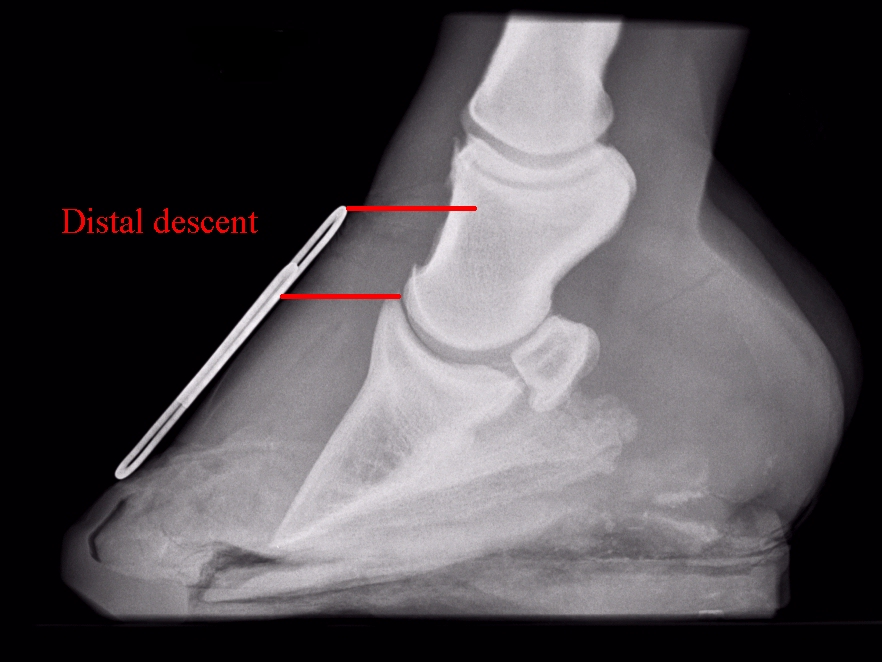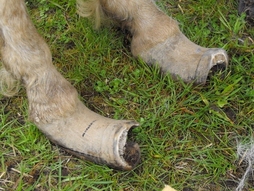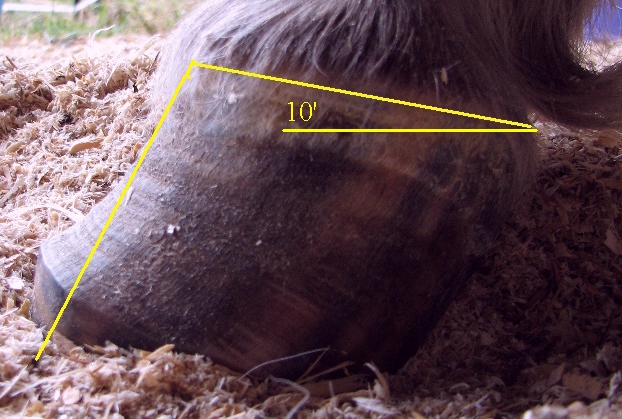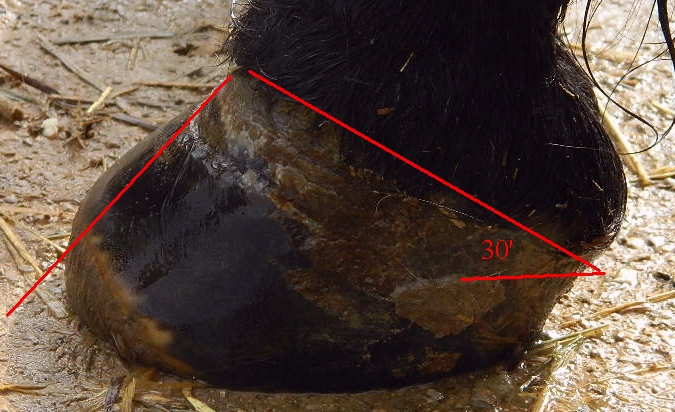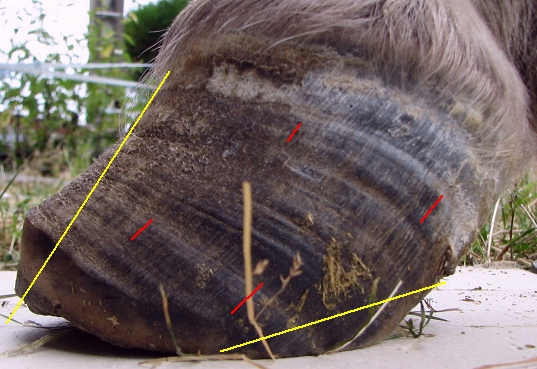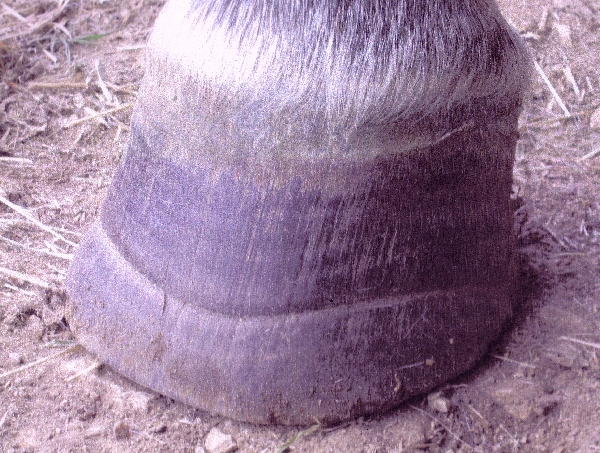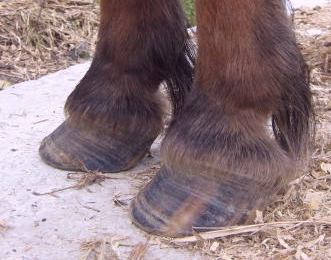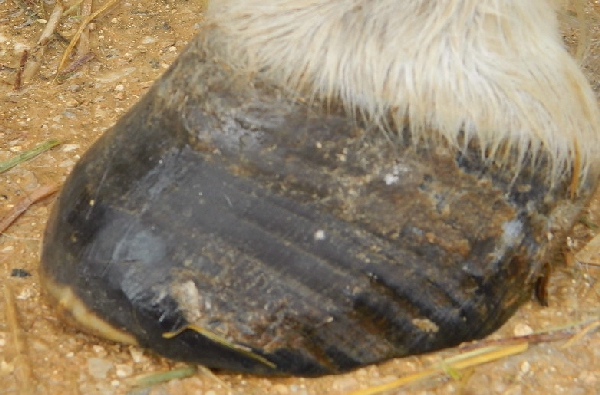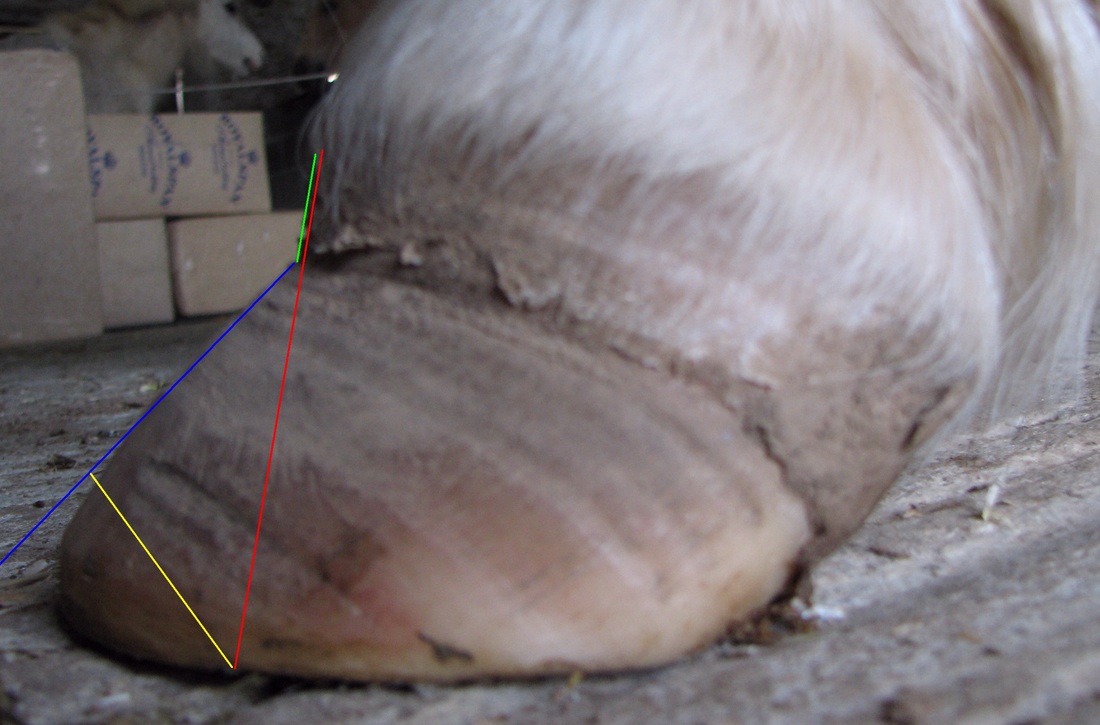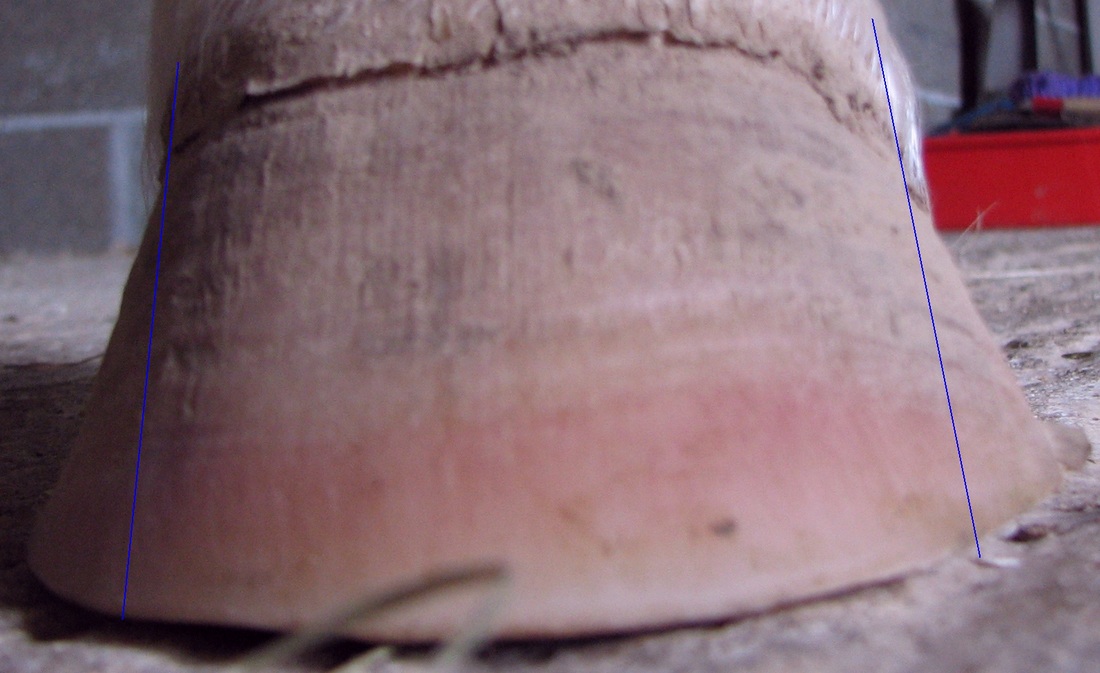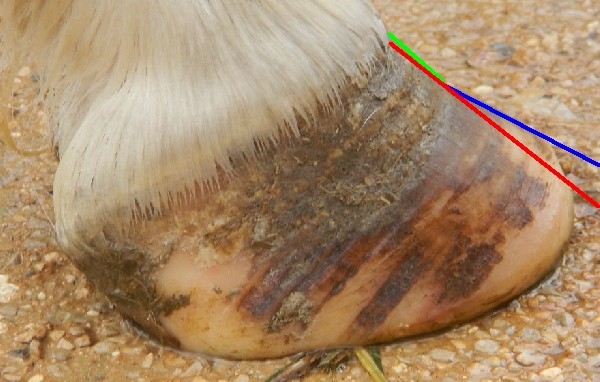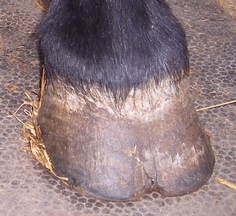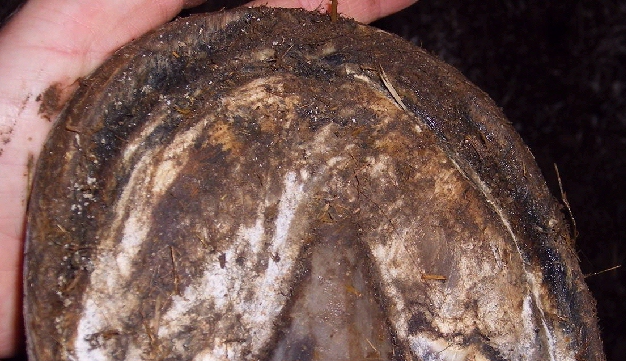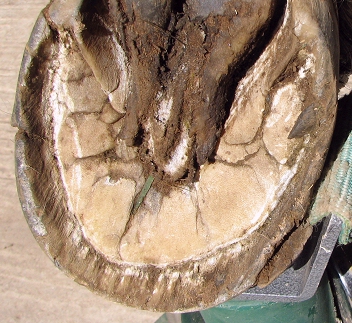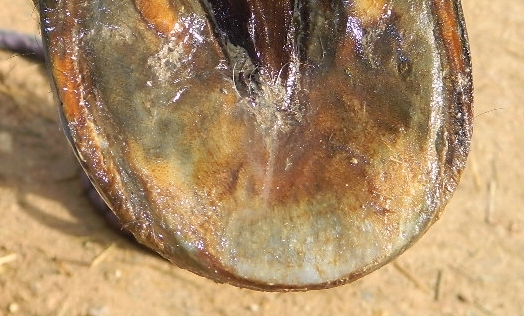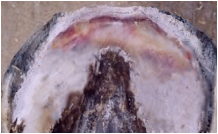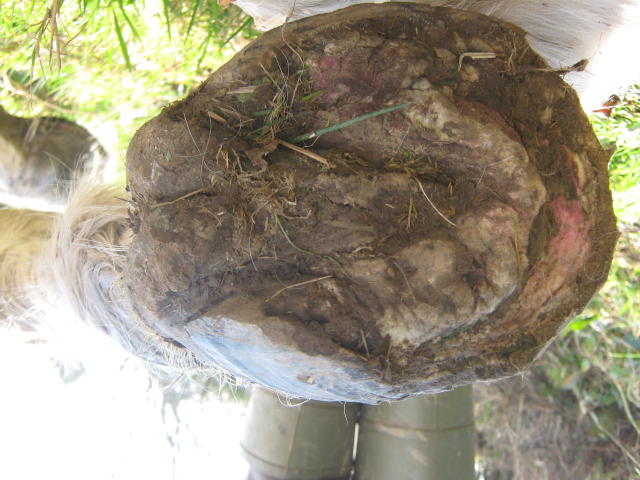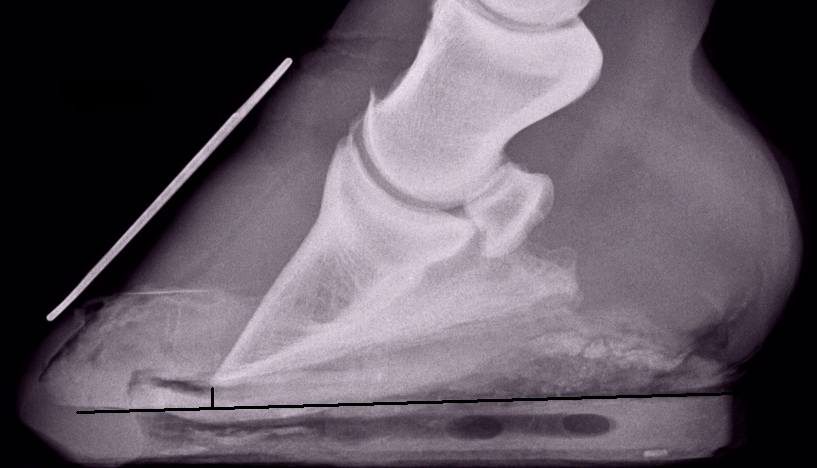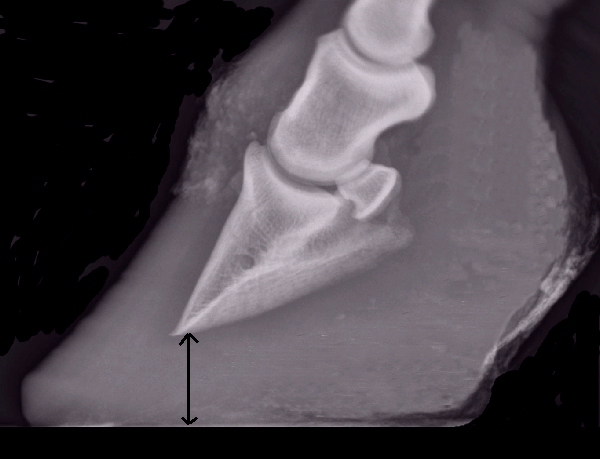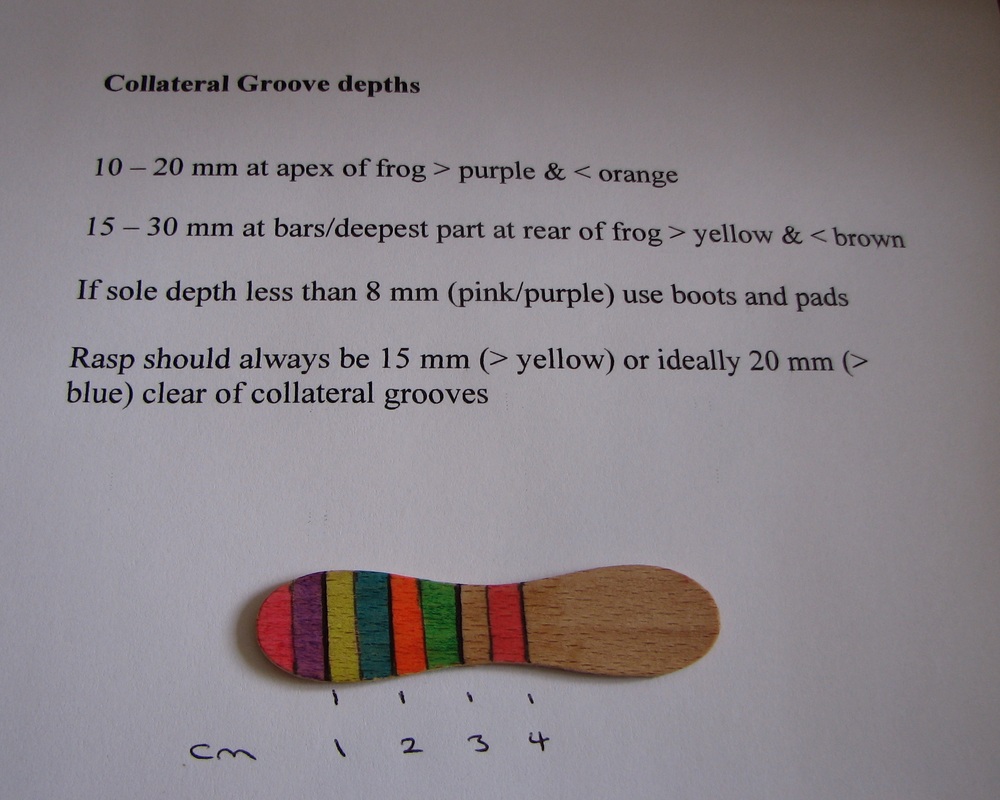Chronic laminitis
|
Chronic laminitis is defined as the rotation or sinking (distal descent) of P3 (the pedal bone/coffin bone). |
Divergent hoof rings and a stretched or separated white line (sometimes with signs of blood or serum) are generally accepted as signs of chronic laminitis, and x-rays should always be taken if these signs are seen.
Symptoms of chronic laminitis
|
Abnormal hoof growth - this is extreme but does happen when feet are neglected. See Cedar's amazing rehab for a happy ending.
|
|
Heels grow quicker than toes, often causing a "boxy" appearance to the hoof with the hair line straighter than normal from toe to heel when viewed from the side (yellow line - left).
Compare to the well trimmed laminitic hoof with sloping hair line (red line - right). |
|
Divergent hoof rings - rings are wider or lower at the heels than at the toes.
Rings on the hoof wall from coronet to ground are an indicator of ongoing chronic/endocrinopathic laminitis. Horses with distal descent (sinking) often have a hoof ring the same distance from the coronet the whole way around the hoof. It takes a minimum of 3 months for new divergent hoof rings to be seen following laminitis (1). Horses can have growth rings as a result of changes in diet or environment rather than laminitis - these will not be divergent. |
Karikoski NP, McGowan CM, Singer ER, Asplin KE, Tulamo RM, Patterson-Kane JC
Pathology of Natural Cases of Equine Endocrinopathic Laminitis Associated With Hyperinsulinemia
Veterinary Pathology 2015, Vol. 52(5) 945-956
"All cases of endocrinopathic laminitis, regardless of their clinical duration, showed chronic pathology in the abaxial region of the hoof wall that in all but 1 horse was correlated with divergent hoof rings."
Karikoski NP, McGowan CM, Singer ER, Asplin KE, Tulamo RM, Patterson-Kane JC
Pathology of Natural Cases of Equine Endocrinopathic Laminitis Associated With Hyperinsulinemia
Veterinary Pathology 2015, Vol. 52(5) 945-956
"All cases of endocrinopathic laminitis, regardless of their clinical duration, showed chronic pathology in the abaxial region of the hoof wall that in all but 1 horse was correlated with divergent hoof rings."
|
Change in hoof wall angle - tight new growth directly below the coronet (green), flared wall with loose laminar connections (blue). Trim required to encourage new tight growth (bevel - yellow, line of new growth - red). Bell shape or bulge in hoof wall. Bruising/redness in hoof walls. Flared walls. Wall cracks. |
|
Deep black groove between wall and sole where tight white line should be.
Blood/haemorrhage in white line. |
Stretched white line (stretched epidermal laminae).
|
Solid laminar wedge can fill the gap between separated wall and sole and can look just like sole, but is often a slightly different colour and often the outline of P3 can be seen.
|
|
|
Bruising on the sole in front of the frog and below the tip/solar edge of P3.
Bulging/convex/dropped sole (photo p61). Depression just above the coronet (photo p61) - as you run your finger down the front of the pastern towards the hoof, your finger "gets stuck" in a dip just above the start of the hoof wall.
Swelling/deformation at the coronary band (photo p2) Penetration of sole by P3 - solar prolapse.
|
Thin sole (above)
or thick sole (below) - thickened sole seems to be more common in ponies. Sole thickness can be estimated by measuring the collateral groove depth. |
|
Large difference in collateral groove depth between front and back of frog.
For most horses a good collateral groove depth at the apex of the frog (measured to the sole by the white line) will be 10-20 mm - less than 10mm is likely to indicate a thin sole; and 15-30 mm at the deepest part (usually near the bars). The greater the difference between the collateral groove measurement at the apex and the back of the frog, the greater the palmar angle and therefore P3 rotation. |
A short video from Daisy Bicking showing signs of chronic laminitis.
Signs of chronic laminitis, which means uncorrected dorsal and/or palmar rotation, seen on the lateral view of the foot include:
- a change of angle in or flaring of the dorsal hoof wall,
- a line through the pastern is not parallel with the toe wall,
- hoof rings that are wider at the heels than at the toe (note hoof rings that are equidistant are not associated with laminitis, although you may sometimes see one pronounced ring which may indicate a laminitic event),
- high heels (heels almost as high as the toe), which will often give the foot a boxy/square look (a healthy foot has a triangular shape from the side),
- accompanying high heels, a shallow hairline angle (when viewed from the side), and
- deep collateral grooves towards the back of the foot.
Signs of chronic laminitis, which means uncorrected dorsal and/or palmar rotation, seen on the lateral view of the foot include:
- a change of angle in or flaring of the dorsal hoof wall,
- a line through the pastern is not parallel with the toe wall,
- hoof rings that are wider at the heels than at the toe (note hoof rings that are equidistant are not associated with laminitis, although you may sometimes see one pronounced ring which may indicate a laminitic event),
- high heels (heels almost as high as the toe), which will often give the foot a boxy/square look (a healthy foot has a triangular shape from the side),
- accompanying high heels, a shallow hairline angle (when viewed from the side), and
- deep collateral grooves towards the back of the foot.
Frequently Asked Questions
Is it the bone or the hoof that moves?
Some people consider that phalangeal/bony rotation (rotation of P3) and capsular rotation (rotation of the hoof capsule) are separate issues. Others consider that there will always be a bit of both.
Robert Eustace (1) says that he prefers to think of an increase in founder distance as proximal (upwards) displacement of the hoof in relation to P3, rather than distal (downwards) displacement of P3, because there is no evidence of increased tension in the DDFT or muscle following relative displacement.
Some people consider that phalangeal/bony rotation (rotation of P3) and capsular rotation (rotation of the hoof capsule) are separate issues. Others consider that there will always be a bit of both.
Robert Eustace (1) says that he prefers to think of an increase in founder distance as proximal (upwards) displacement of the hoof in relation to P3, rather than distal (downwards) displacement of P3, because there is no evidence of increased tension in the DDFT or muscle following relative displacement.
Further information
After the Crash - Lessons from Chronic Laminitis - Professor Christopher C Pollitt BVSc, PhD (www.safergrass.org)
References
(1) Vet Clin North Am Equine Pract. 2010 Aug;26(2):391-405. (PubMed)
Clinical presentation, diagnosis, and prognosis of chronic laminitis in Europe.
Eustace RA.
Clinical presentation, diagnosis, and prognosis of chronic laminitis in Europe.
Eustace RA.
